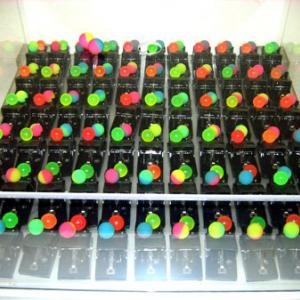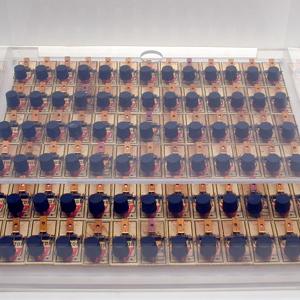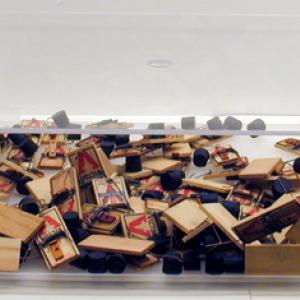College of Liberal Arts & Sciences
7D20.10 - Mousetrap Chain Reaction
Place the plate with the mousetraps mounted on it on top of the Lucite box base plate. Set the traps and place two super ball neutrons on each trap. Make sure one of the neutrons is sitting in the hole on the mousetrap. When done setting all the neutrons you may place the cover on the apparatus. Trigger by dropping a neutron in the hole in the cover.
Place the bottom of the Lucite box on a table, set the mousetraps and set them in rows on this bottom. Very carefully place the rubber stoppers on the mousetraps so that they have enough stability to be gently moved into the lecture room. Using one stopper as a trigger, drop it in the hole on the top of the Lucite box and observe the reaction. Preparation time is at least 30 minutes. This Demo has been video taped several times so that after you have done the reaction you can play the video in slow motion and see how the reaction evolves. The tape is in the video cabinet labeled 'Atomic Bomb - Mousetrap Exp.'.
- "Figuring Physics", TPT, Vol. 35, #9, Dec. 1997, p. 539.
- "Figuring Physics", TPT, Vol. 35, #8, Nov. 1997, p. 502.
- Andrew DePino, Jr., "A Pile of Legos", TPT, Vol. 32, #5, May 1994, p. 300.
- Robert Marzewski, "Chain Reaction Model", TPT, Vol. 26, #8, Nov. 1988, p. 514.
- J. Higbie, "The Better Mousetrap: A Nuclear Chain Reaction Demonstartion", AJP, Vol. 48, #1, Jan. 1980, p. 86.
- Hans G. Graetzer, "Discovery of Nuclear Fission", AJP, Vol. 32, #1, Jan. 1964, p. 9.
- Esther B. Sparberg, "A Study of the Discovery of Fission", AJP, Vol. 32, #1, Jan. 1964, p. 2.
- H. D. Rathgeber, "Mousetrap Model of Chain Reactions", AJP, Vol. 31, #1, Jan. 1963, p. 62.
- R.M. Sutton, "A Mousetrap Atomic Bomb", AJP, Vol. 15, #5, May 1947, p. 427.
- J.H. Manley, "The Mousetrap Bomb: Modification N+1", AJP, Vol. 16, #2, Feb. 1948, p. 119.
- L.A. Whitehead, "Domino Chain Reaction", AJP, Vol. 51, #2, Feb. 1983, p. 182.
- I. Perissi and U. Bardi, Revisiting the Moustraps Experiment: Not Just About Nuclear Chain Reactions, Systems, Vol. 10, #4, 2022, p. 91.
- MPa-1: Freier and Anderson, A Demonstration Handbook for Physics.
- S-260: "Marbles in Saucer", DICK and RAE Physics Demo Notebook.
- S-265: "Mouse Traps & Silicone Balls", DICK and RAE Physics Demo Notebook.
- Cy Tymoney, "Sneaky Atomic Fundamentals Simulation", Sneakiest Uses for Everyday Things, p. 124.
- Bobby Mercer, "Chain Reaction", Junk Drawer Chemistry, 2016, p. 169.
- Robert Ehrlich, "12.1 - Chain Reaction Simulation", Why Toast Lands Jelly-Side Down, p. 179.
Disclaimer: These demonstrations are provided only for illustrative use by persons affiliated with The University of Iowa and only under the direction of a trained instructor or physicist. The University of Iowa is not responsible for demonstrations performed by those using their own equipment or who choose to use this reference material for their own purpose. The demonstrations included here are within the public domain and can be found in materials contained in libraries, bookstores, and through electronic sources. Performing all or any portion of any of these demonstrations, with or without revisions not depicted here entails inherent risks. These risks include, without limitation, bodily injury (and possibly death), including risks to health that may be temporary or permanent and that may exacerbate a pre-existing medical condition; and property loss or damage. Anyone performing any part of these demonstrations, even with revisions, knowingly and voluntarily assumes all risks associated with them.


